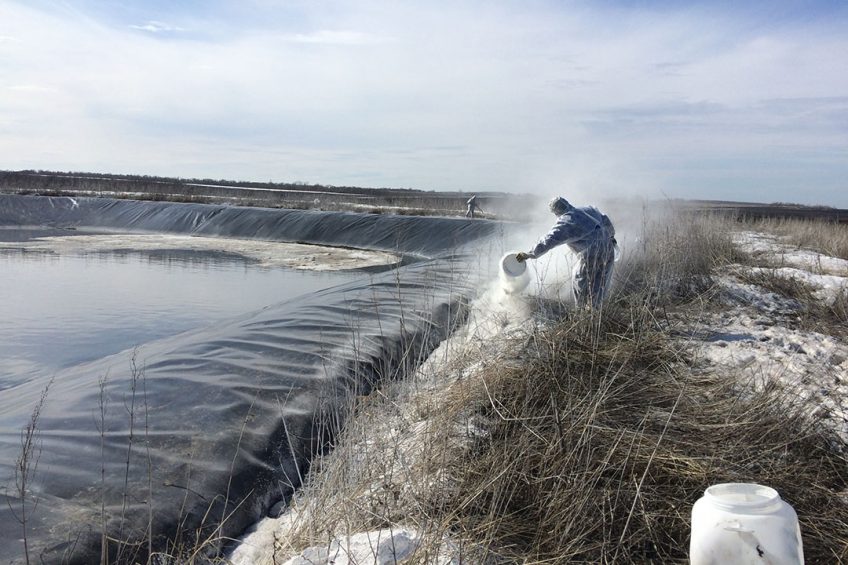ASF on-farm? Back on track in 18 steps – part 2

African Swine Fever (ASF) arrived in China, the world’s largest pig market and has been spreading rapidly across countries, provinces, towns and counties of Asia. Now what to do in practice when the virus pops up? This is part 2 of a checklist for pig producers and veterinarians – steps 10 – 18.
Never before in history, has African Swine Fever virus (ASFv) had the opportunity it is having right now. Up until recently, the virus was spreading slowly through different pig populations. What happened in 2018, however, was completely new. The virus moved thousands of kilometres and infected thousands of animals in a very short period of time. In addition, environmental conditions changed as the presence of the virus in the environment is likely to be much higher. Still, the mechanism to control the infection, to avoid it spreading and to manage the farm after an outbreak remains the same. It is just a matter of applying all the measures more vigorously.
The aim of this article is therefore to help vets and producers to do so, once confronted with an ASF infection. It contains a summary of 18 steps that can be followed, either to control the spread of the disease on-farm once it is infected or to prevent the virus entering onto other farm sites. In addition, the article provides information about the best way to repopulate a farm.
This paper is based on the experience of controlling ASF in large pig production systems and also the knowledge acquired after travelling to China on various occasions trying to answer questions from colleagues and producers. It’s therefore good to keep in mind that some recommendations might vary under different circumstances or scenarios.
In short, the article revolves around 2 questions: What to do when facing an ASF outbreak? And what is the best protocol to follow starting a proper repopulation?
 Intensive cleaning of tools – phase I
Intensive cleaning of tools – phase I
As ASFv is very resistant, it is vital to clean and disinfect properly all materials that may have been in contact with the virus. Applying one methodology is advised, so to…
- Perform a mechanical removal of all organic material (feed, faeces, dirt) using brushes and shovels;
- Hand wash water-sensitive equipment (e.g. temperature controllers), using a cloth soaked in disinfectant before covering it with plastic;
- Dispose and burn equipment that cannot be properly disinfected;
- Spray water on all surfaces with a hose or a sprinkler.
- Apply alkaline detergent to all surfaces;
- Rinse with water and allow time for drying;
- Apply disinfectant to all surfaces following manufacturer’s instructions and allow a minimum of six hours of contact;
- Increase room temperature when possible.
 Intensive cleaning of tools – phase II
Intensive cleaning of tools – phase II
Following the same methodology, the next steps include…
- Dismantle the farm equipment (slats, feeders, feed lines);
- Perform a mechanical removal of all organic material with the help of brushes and shovels;
- Spray water and apply alkaline detergent to all surfaces;
- Rinse with water and allow time for drying;
- Apply disinfectant to all surfaces following manufacturer’s instructions and allow a minimum of six hours of contact;
- Increase room temperature when possible;
- Disinfect the equipment used for disinfection with a cloth soaked in disinfectant or using disinfectant vapour;
- Dispose of and burn all clothing used during the disinfection.

 Intensive cleaning of tools – phase III
Intensive cleaning of tools – phase III
Following the same methodology, the last steps include…
- Apply disinfectant to all surfaces by low pressure sprinkling or using powder disinfectant;
- Allow for a minimum of six hours of contact;
- Increase room temperature when possible;
- Seal the farm area and forbid any access to it.
 ASF outside the pig barns
ASF outside the pig barns
Once all the internal facilities are cleaned up, there may still be environmental contamination outside the buildings from a variety of sources. That is a potential source of virus and a high risk for the virus re-entering the farm. It is essential to…
- Cover all farm territory with powder disinfectant 25% dry bleach at a rate of 2kg/m2;
- Mix lagoon manure with 25% dry bleach at the rate of 1.5kg per 10 dm3;
- Remove the upper layer of the covered pits – this must be buried in a new pit;
- Dispose of any feed left inside feed bins – this must be buried in the pits;
- Disinfect feed bins using sprayers;
- Fence off the entire pit area to avoid access by people or animals;
- Burn clothes worn during this phase;
- Seal the entire farm and forbid access until quarantine is lifted.
 Bioassays
Bioassays
Restarting the business should be one of the priorities for every company hit by ASFv. That is not an easy task, as ASF is extremely resistant to the environment. It will take time, massive efforts, resources and repetition, because under recontamination is frequent. What is under recontamination?
As African Swine Fever is a notifiable disease for the World Organisation for Animal Health (OIE), the repopulation time may be controlled by local authorities, depending on the country. Once authorities allow repopulation, it is recommended that a bioassay (sentinel introduction) is started. A bioassay is an analytical method to determine concentration or potency of a substance by its effect on living cells or tissues. Bioassays are used to estimate the potency of agents by observing their effects on living animals (in vivo) or tissues (in vitro). In short – it will confirm whether a farm is clean enough for repopulation.

 Sentinel introduction procedures
Sentinel introduction procedures
Introducing sentinels is best, following these steps. It is essential to…
- Select a reliable source of animals;
- Confirm through lab testing whether this source is free from major diseases;
- Arrange transportation with a clean and disinfected truck;
- Recruit staff willing to live on the farm for 60 days;
- Deliver the required feed for the entire 60-day period;
- Confirm with laboratory testing that feed and water is negative to ASFv;
- Deliver the animals (5-10% of farm capacity);
- Wash and disinfect the truck used, and apply downtime, before going to other sites.
 Sentinels – what to do?
Sentinels – what to do?
In nurseries and finisher farms, in total two to three pigs should enter per pen. Some pigs should be allowed to walk freely through hallways and corridors. Similarly, in sow farms, it is not advisable to lock the animals in crates. They also should be allowed to have access to all farm areas. If necessary, physical barriers can be used to prevent them from staying in one area.
 Monitoring the sentinels
Monitoring the sentinels
After the introduction of the animals onto the farms, it is important to…
- Monitor the sentinel pigs for 60 days;
- Perform a weekly PCR testing of live animals using whole blood of a statistical significant amount;
- Have all dead animals inspected by a vet. Tissues should be submitted for laboratory testing (e.g. kidney, tonsils, lymph nodes, lungs and spleen);
- Collect blood samples from all the pigs at the end of the 60-day period. ELISA testing should be carried out for antibodies and PCR testing for antigen detection.
 Finally! ASFv is gone
Finally! ASFv is gone
Once all procedures have been completed, and all quarantine periods are over, and once all tests have returned negative for ASFv at any timepoints – only then is the farm ready for the ultimate goal: total repopulation.











